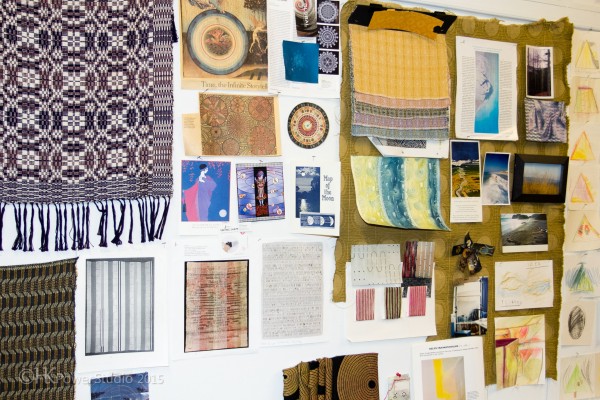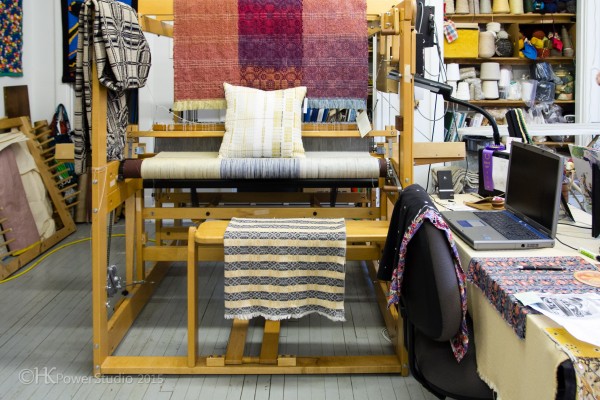Interview by Heather Powers
A few weeks ago, before all the winter weather hit, a colleague of mine from my Savannah College of Art and Design days, Heather Powers, visited me in my studio. Like me, Heather is a victim of the downsized (read "relocated") textile design field in the carpet and and upholstery industries. She has remade herself as an organizer of creative spaces (HKPowerstudio.com). What follows is her interview with me about how and why I organize and maintain my studio space the way I do. In the process of answering her well thought-out questions, I realized that a little part of me subscribed to the "artists have to be messy to be creative" school of thought. I always felt a little guilty when I turned on the vacuum cleaner in my studio. And to make things worse, I felt bad about feeling guilty! So Heather's probing questions got me to sit down and give time to thinking about why I do things the way I do, and now I understand that my organization and neatness is actually my way of honoring my creativity and the gorgeous space I am so lucky to have. Thank you Heather! (all photos by Heather Powers, excerpted from her Blog)
Inside the Artist Studio::Selinde Lanier
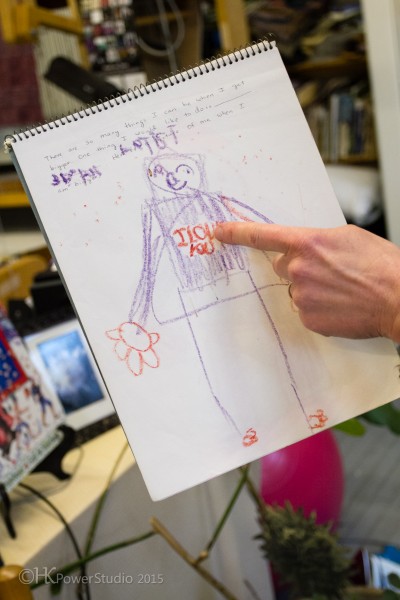
HKPS:: What age did you suspect or know you were an artist?
SL:: I just found a picture that I drew of myself in kindergarten in answer to a prompt “One of the things I can be when I grow up is:” and I wrote “Artist” and then drew a picture of myself with huge hands and a shirtdress that read I Love You on it. I found this picture while I was sifting through old boxes of my art work on a mission from an Artist’s Way exercise and I did not remember making it. It was possibly the biggest gift my little self could have given to my grownup self to validate my doing now what I truly love – visual art. I spent my youth pursuing classical music and then gave that up as too competitive and confining, only later discovering weaving and textile design. So to find that I had once cherished the goal of becoming an artist, specifically a maker with big, powerful hands, was incredibly powerful and a lovely reminder that I have, after all, followed my path.

HKPS:: What mediums do you work with and are there specific tools or materials you find challenging to keep organized or locate when you need to use them?
SL:: I work primarily with natural fiber yarn in large quantities. I also do a lot of natural dyeing. Since my studio is quite bright and not air conditioned, I face two main storage issues: keeping the naturally-dyed yarn and dyestuff (dried plant material) out of direct light as well as sealed away from insects. The light issue I addressed early on by having lightfast-lined curtains installed, done soon after I moved into my studio because the very direct southern light was also causing a mechanical problem with flooding a light sensor on my dobby loom.
Fortunately the closet that I keep my yarn in is on the opposite side from where the sun primarily shines so I just make sure to always keep the curtains closed on that side of the room. As far as insects go, I seal any valuable yarn in plastic Ziploc bags and plant material in opaque plastic yogurt containers. Leftover dyebaths that aren’t exhausted I keep frozen in a freezer in my studio.
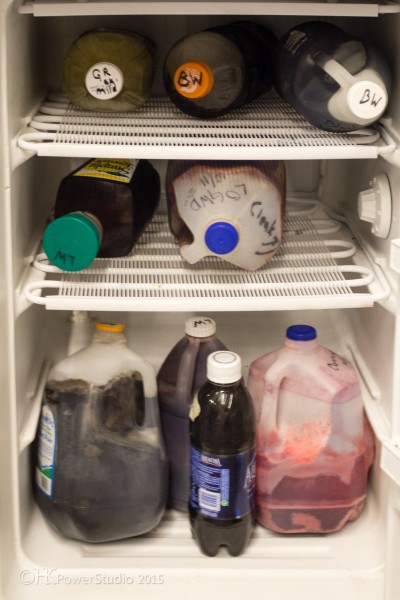
HKPS:: Where do you make your art, how big is your studio and how long have you been in this space?
SL:: My studio is located in the restored Marshall High Studios building in downtown Marshall, NC. It’s the size of a classroom complete with chalkboard at one end opposite built-in closets on the other and a wall of bulletin board opposite four large windows that look down onto a tree-lined half of the French Broad River (half because the building a resides on an island in the middle of the river). I have been there since October of 2008, on the second floor, directly above Rob Pulleyn, owner and renovator of the building, who along with wife Kate Matthews, started FiberArts Magazine 40 years ago. It is truly an honor and inspiration to make fabric in a studio over the editor of the magazine that got me started in this field to begin with.
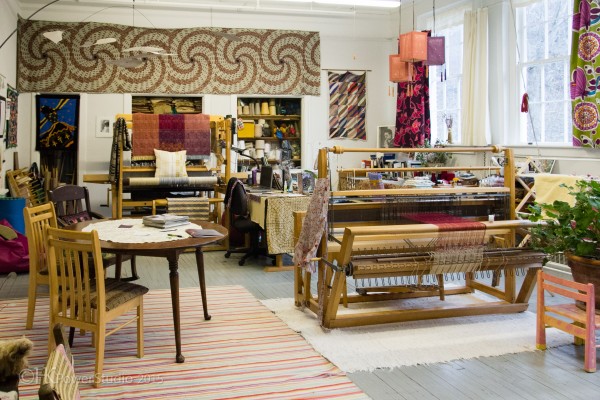
HKPS:: How many projects are you usually working on at once? Is this due to space constraints, creative process, organizing systems or other influences?
SL:: I never seem to have the bandwidth to be working on more than one project at a time, although I have a 24 harness dobby and a 60-inch 4 harness LeClerc that almost always have the end of a warp on them holding the old threading on the chance I can use it for the next project. Maybe this is a holdover from the industrial world I used to work in where you never let your machinery go idle. Or maybe it’s just weaverly wisdom, since threading is so time-consuming. Either way, theoretically I could be switching from loom to loom, weaving several things at a time. I don’t seem to however. I have always been one to finish things that I start before launching something new, preferring to work linearly. We do so much multitasking in our everyday lives now that I actually find this singular concentration therapeutic and even luxurious. That said, I usually have at least two journals and a sketchbook going at one time, places to store the myriad of ideas that pop into my head so that I can access them easily whenever I need to.
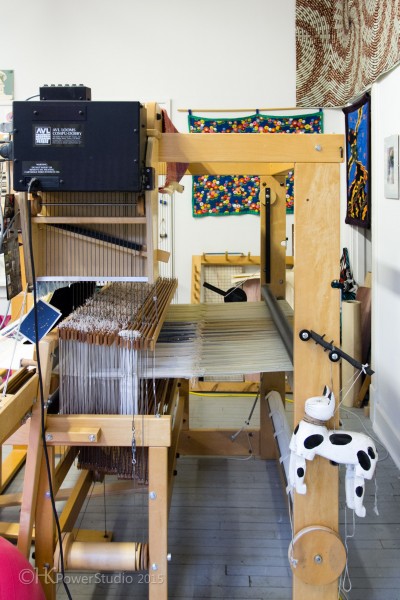
HKPS:: When you began working in this space did you plan any systems for the overall set up or did you let things evolve organically? How did past studio spaces or systems influence this space?
SL:: Right away, I had shelves built for the closets so that I could finally unpack 15 years of a life in textiles; mainly yarn, books and fabric. I had moved into this studio from a much smaller space, mainly because I had purchased a dobby loom that wouldn’t fit into the space I had. So once I had the shelves built, loom set up and brought in two work benches, I got to work.
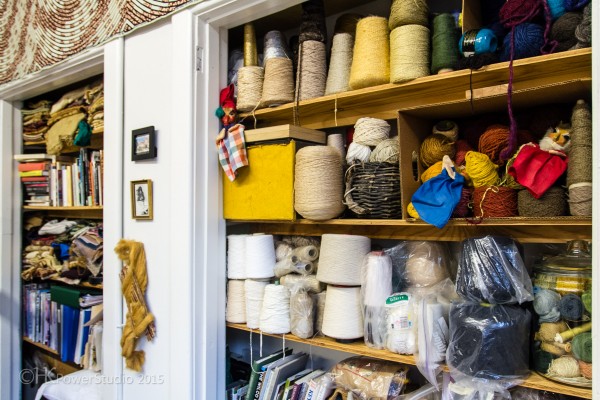
HKPS:: Do you consider yourself to be an organized person? How or where (another artist or gallery?) did you learn your organizing habits and systems?
SL:: I do think of myself as organized, but only to a certain degree. I get things into piles or certain neat sections, but then it stops there and I don’t really problem solve much beyond that. I would call it a marriage between neatness and organization, enough of both so that I know where things are when I need them and don’t go crazy tripping over stuff in my way but not organized to a finer level beneath serving that purpose. I am a German/Dutch hybrid who grew up in a well-kept but not airless house so I think it comes naturally. There are pictures of me as a child in a dirndl vacuuming and even now, I have a bit of a reputation for wielding a broom. I do like a clean floor.
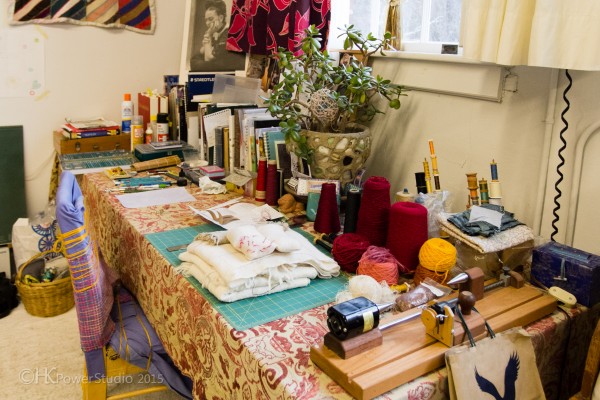
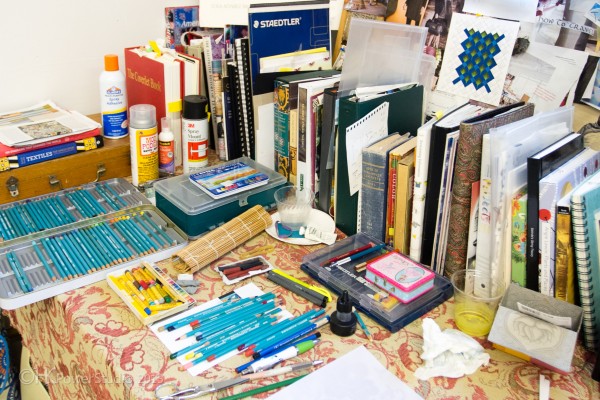
HKPS:: What tips can you offer regarding your use of schedules, systems, tools or processes that help you maintain organization in your studio? Do you purge, clean or de-clutter your supply stash and space on a regular basis?
SL:: I do purge, though not more than once every few years. I am trying with a capital T to not collect more than I need, though orphaned looms still seem to find their way to me, as do stashes of yarn. I am still using yarn that I bought 15 years ago so I am loathe to purge yarn or fabric but I do go through and get rid of newspaper/magazine clutter on a regular basis. I have to vacuum after every weaving project and especially during long phases on the dobby as it produces large lint rolls. I also have a fairly public space, and people visit the studio weekly, as well as attend monthly meetings there. So I feel some compulsion to keep a presentable space for that reason as well.

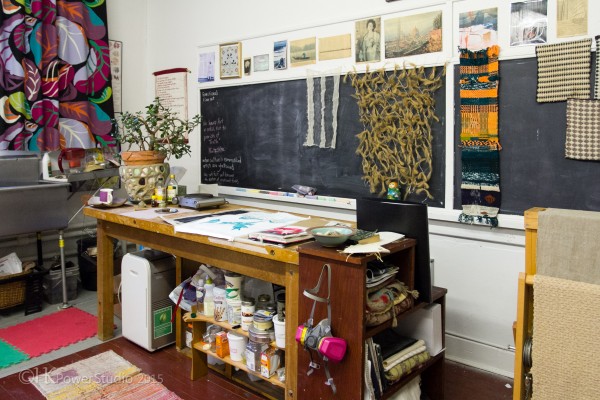
HKPS:: Please describe how creative cycles of organization or dis-organization affect your creative process? Are there certain phases of projects that are more or less organized? (ex. I can’t focus unless things are put away, creative chaos inspires me, things get messy as I work but I clean up at the end of projects)
SL:: I would fall into the let-it-get-messy-til-I’m done category. I don’t like to take the time to clean while I’m in the zone – what’s the point? It is an art studio! I have also had moments where I’ve been going through boxes of things, looking for something, and found something totally different that took me into a whole new realm of inquiry and so to a certain degree, I think having things laid out all over the place can be productive for creative fermentation. But of course, after a while, I find I simply have to push things out of the way to move forward with a certain project. And that’s where the cleaning up so I don’t trip over my piles comes into play.
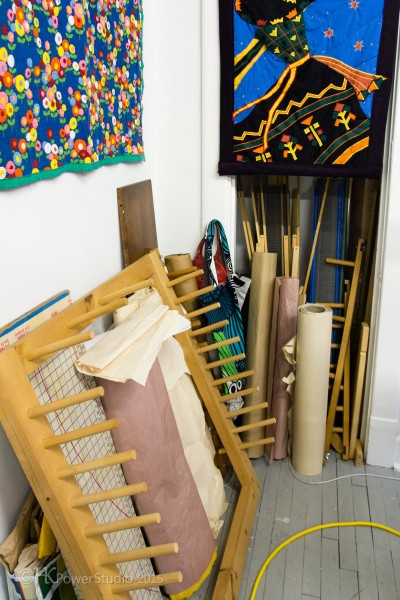
HKPS:: How much thought do you give to your artistic body of work in terms of historic value and the overall legacy you will leave behind? How do you store/archive your work or records?
SL:: I have tried to be consistent in maintaining a print and digital portfolio, but the digital version gets harder and harder to keep up as computers die and methods of storage evolve. I would actually welcome some instruction on digital backup. (HKPS-I’ll be considering in what way I may be able to provide assistance with this). Maintaining a print portfolio however is a fun and immediately gratifying way to quickly show the range of my work. I also maintained a blog from the time I first moved into this studio until last spring – about 5 years – and last year had it published. This was an amazing thing for me to hold in my hands. The sheer heft of the resulting book made me appreciate how much of my work consists of my writing about it! Regarding the work itself, I have kept track of where all the big pieces have gone though could do a better job of documenting that. I recently started consciously keeping or gifting bits of my work to family members so that I could guarantee having examples of it left to my loved ones. This has felt a bit selfish and even macabre, but as a female artist, and especially one whose medium is fiber, that ghetto child of the art and craft world, I think it is even more important that I document and preserve my own ouvre. You never know how important it may be to someone one day.
